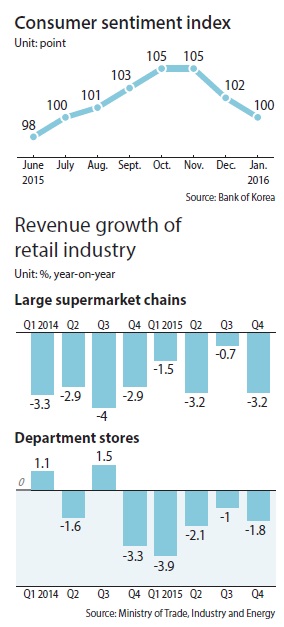Consumer sentiment poor at start of year

According to the central bank, its composite consumer sentiment index fell two points to 100 in January from a month earlier, due to worries in the financial markets and phase-out of policies including a temporary cut in the nation’s individual consumption tax.
A reading above 100 indicates that there are more consumers with positive outlooks about the economy, while a reading below the mark means pessimists outnumber optimists.
Consumer sentiment showed noticeable improvement since July as the domestic market recovered from the outbreak of Middle East respiratory syndrome (MERS), largely owing to government-led sales events. The index recorded 105 in October and November, when retailers rolled out discount events at an unprecedented level under the names K-Sale and Korea Black Friday.
But consumers are more pessimistic about the economy’s outlook in the next six months, as a sub-index showed a drop from 84 in December to 78 in January. It is the lowest since January 2012.
While sentiment about income growth dipped one point to 100, expectations about higher expenditures stood at 107, unchanged from the previous month. The figures suggest more consumers are expecting their incomes to remain the same even as expenditures rise, increasing their financial burden.
With the nation’s total household debt hovering at around 1,200 trillion won ($1 trillion), consumers are feeling the push to make ends meet and closing their wallets.
The latest drops in consumer sentiment trigger worries about materialization of the so-called consumption cliff this year, referring to a severe contraction in consumption.
As the news came just one day after the central bank announced that quarterly economic growth fell back to below 1 percent, with weak improvement in consumption in the fourth quarter of 2015, concerns are mounting that consumption might weaken even more in the first quarter of this year, especially since major government efforts to boost consumption ended in December.
“The government needs to do something before the Lunar New Year holiday about the weak improvement in the domestic sector,” said Lee Chang-seon, a research fellow at the LG Economic Research Institute.
What makes the outlook even more frustrating is that local retailers reported worse-than-expected performance last year despite the policy efforts.
The revenue of large supermarket chains declined 2.1 percent in 2015 compared to a year earlier, while that of department stores shrank 1.2 percent year on year and hypermarkets - smaller supermarkets in residential areas operated by retail conglomerates - saw a 1.3 percent dip, according to the Ministry of Trade, Industry and Energy on Wednesday.
Most players in the retail industry suffered due to a 10.2 percent decline in private consumption in June after the MERS outbreak. The impact of state-led consumption stimulus policies later in the year was not enough to offset the sharp drop.
Warm weather in December, when the average temperature was 1.6 degrees Celsius (34.9 degrees Fahrenheit), was another culprit that brought down the revenue of large supermarket chains by 5.1 percent, as sales of winter products during the month dipped significantly.
“Retail sales slowed overall, but department store revenue grew slightly by 0.3 percent compared to a year earlier when excluding data from June and December [when consumption fell due to external reasons like MERS and the weather],” a ministry official said.
Department store revenue in the fourth quarter grew slightly thanks to increased sales of luxury jewelry and home appliances after the government temporarily exempted the goods from the individual consumption tax in the latter half of last year to boost spending.
The revenue of large supermarket chains like E-Mart and Homeplus, however, only saw 1 percent year-on-year growth in 2015, even when excluding June and December data, mainly due to changes in consumer shopping habits.
Consumers mostly moved to large online shopping malls like G-Market and 11st for daily supplies and discount outlet malls for fashion products.
Online shopping transactions grew 19.5 percent in the first 11 months of last year compared to a year earlier, while discount outlet shop revenue also grew 10 percent during the same period.
Convenience stores were the only type of retail business that saw revenue rise last year, by 26.5 percent compared to 2014, thanks to the recent popularity of prepackaged lunches and snacks, as well as high tobacco sales despite a tax hike.
BY SONG SU-HYUN, KIM JI-YOON [song.suhyun@joongang.co.kr]










with the Korea JoongAng Daily
To write comments, please log in to one of the accounts.
Standards Board Policy (0/250자)